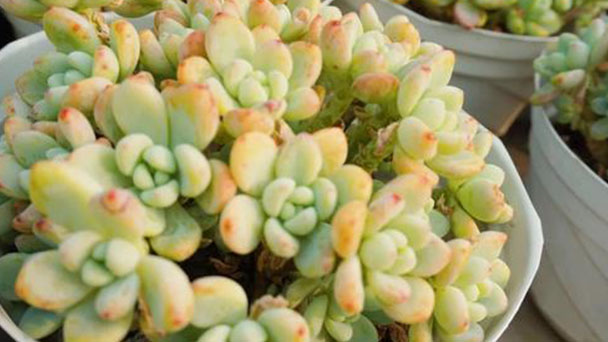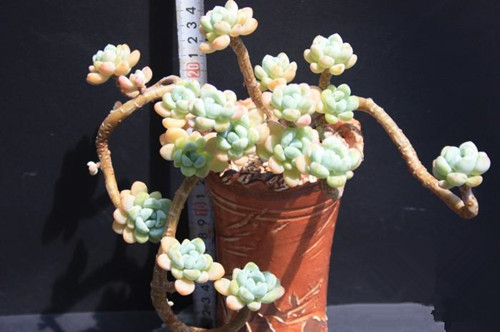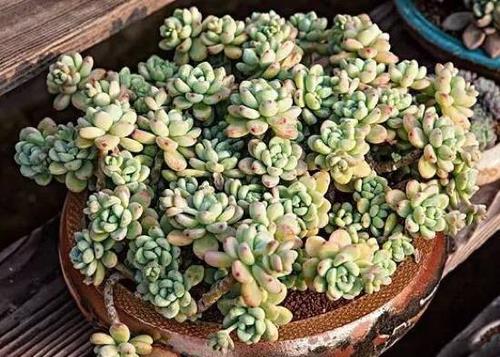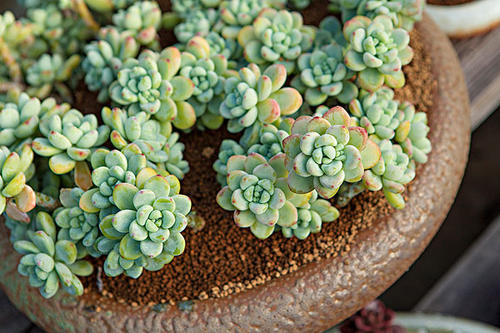Sedum Clavatum profile
Written by Maggie
Sep 23 2021

Sedum Clavatum is a species of Sedum aldum, a perennial bulb flower, with a three-year sexual maturity, moderately light-loving, slightly shade tolerant, and moderately warm.
Sedum Clavatum picture

Sedum Clavatum morphological characteristics
Sedum Clavatum is a perennial subshrub, much branched, and liposomes often produce new buds from the lower part of the stem, forming groups. Leaves are spatulate, alternate, arranged in rosette. The surface is bright and clean, the front is flat, the back is slightly uplifted, fleshy and thick, emerald green or tender green, on the leaf surface is powdery, giving dense, extremely delicate white grain fully. In sufficient light, the temperature difference between the environment, the tip will appear beautiful lovely little red dots, the color of the leaves into jelly like light green or yellow-green, like frozen transparent, elastic blowing to break the jade fat. In spring it produces clusters of small white flowers with pink pistils.
There are two different forms of lotus. One kind of leaf is relatively long and narrow, frost powder is less. One has wider leaves and more frosting powder (sometimes called "Raul"). But both of these forms belong to the species Sedum Clavatum.
Sedum Clavatum growing environment
Sedum clavatum prefers a cool, dry, sunny environment and well-drained sandy soil.
Sedum Clavatum distribution area
Sedum Clavatum is found in the wild, on rock walls or andesites, in Mexico. The variety is now widely grown in many parts of the world.

Sedum Clavatum pests and diseases
Sedum Clavatum's insect infestation is dominated by scale insects. More than 80% of Sedum Clavatumpurchased from flower markets and other places had scale worms in their roots. Initial insect pests are common in the roots or the center of the plant. Immediately isolate with other plants after finding insect pests, cut off the root where scale insects breed, and spray flower protectants or infuse roots to kill them (bactericides such as cordyceps sinensis and carbendazim have no insecticidal effect. Complete destruction of scale insects may take several cycles. A small amount of carbofuran or carbendazim can be mixed into the soil for prevention.
Sedum Clavatum is predominantly plant black rot (blackening and rotting of plant parts, mostly at the roots) and occurs in the summer months, usually due to poor ventilation and high humidity and temperature, but may also be caused by scale insects. The decaying parts can be completely cut off in the early stage. A little fungicide (chlorothalonil, carbendazim, etc.) can be applied to the incision. After the incision is dried, it can be inserted into the loose sand soil to root again. If black rot has spread to the plant's growing point, it is considered dead. Discard early to prevent infection. Other diseases (such as bituminous coal disease) can be treated by spraying diluted chlorothalonil, carbendazim and other fungicides. Prevention can be mixed with a little chlorothalonil, carbendazim and other fungicides in the soil. Know more about Sedum Clavatum care and Sedum Clavatum propagation.

Latest Updated
- Benefits of Bugleweed - 7 Science-backed Health Benefits
- Bugleweed Dangers & Side Effects - Is It Poisonous?
- How to Plant Evergreen Trees - What You Should Know
- When to Plant Evergreens - Grow Guide for Evergreen Trees
- 12 Wonderful Evergreen Shrubs for Your Garden
- 12 Popular Evergreen Plants with Pictures for Beginners
- When And How To Prune A Lilac Bush Like a Pro
- How to Grow & Care for Lilac Vine (Hardenbergia Violacea)
- Japanese Lilac Tree (Syringa Reticulata) Care & Propagation Guide
- Shumard Oak Pros and Cons - What to Know
Popular Articles
- Winter maintenance of Antirrhinum Majus
- How to Grow Terminalia Mantaly Tree
- How to Grow and Care for Crossostephium Chinense
- How to grow Antirrhinum Majus in spring
- Peristeria Elata (Dove Orchid) Profile: Info & Care Guide
- Underwatered Snake Plant (Sansevieria Trifasciata) - Signs And How To Fix
- How to Care for Brazilian Jasmine Plant (Mandevilla Sanderi)
- How to Grow & Care for Graptopetalum Purple Delight in Summer
- Rosa Chinensis (China Rose): Plant Growing & Care Tips
- How to Care for Baby Sun Rose (Aptenia Cordifolia)